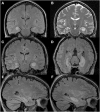The human hippocampus beyond the cognitive map: evidence from a densely amnesic patient
- PMID: 25309387
- PMCID: PMC4164002
- DOI: 10.3389/fnhum.2014.00711
The human hippocampus beyond the cognitive map: evidence from a densely amnesic patient
Abstract
We tested a densely amnesic patient (P9), with bilateral hippocampal damage resulting from an autoimmune disorder, and 12 age- and sex-matched controls on a series of memory tasks designed to characterize allocentric spatial learning and memory abilities. We compared P9's ability to perform spatial memory tasks with her ability to perform non-spatial, color memory tasks. First, P9's performance was impaired as compared to controls even in the simplest versions of an allocentric spatial memory task, in which she had to find repeatedly over 10 trials the same location(s) of one, two or three illuminating foot pad(s) among 23 pads distributed in an open-field arena. In contrast, she performed as well as controls when she had to find repeatedly over 10 trials the same one, two or three pad(s) marked by color cue(s), whose locations varied between trials. Second, P9's performance was severely impaired in working memory tasks, when she had to learn on a trial-unique basis and remember the location(s) or the color(s) of one, two or three pad(s), while performing an interfering task during the 1-min interval separating encoding and retrieval. Without interference during the retention interval of the trial-unique tasks, P9's performance was partially preserved in the color tasks, whereas it remained severely impaired in the allocentric spatial tasks. Detailed behavioral analyses indicate that P9's memory representations are more limited than those of controls both in their precision (metric coding) and in the number of items that can be maintained in memory (capacity). These findings are consistent with the theory that the hippocampus contributes to the integration or binding of multiple items, in order to produce high-resolution/high-capacity representations of spatial and non-spatial information in the service of short-term/working and long-term memory.
Keywords: amnesia; declarative memory; interference; medial temporal lobe; memory capacity; parahippocampal; spatial memory.
Figures









Similar articles
-
Human short-term spatial memory: precision predicts capacity.Cogn Psychol. 2015 Mar;77:1-19. doi: 10.1016/j.cogpsych.2015.02.001. Epub 2015 Mar 2. Cogn Psychol. 2015. PMID: 25727897
-
Rat spatial memory tasks adapted for humans: characterization in subjects with intact brain and subjects with selective medial temporal lobe thermal lesions.Physiol Res. 2002;51 Suppl 1:S49-65. Physiol Res. 2002. PMID: 12479786
-
Allocentric spatial learning and memory deficits in Down syndrome.Front Psychol. 2015 Feb 16;6:62. doi: 10.3389/fpsyg.2015.00062. eCollection 2015. Front Psychol. 2015. PMID: 25762946 Free PMC article.
-
Working Memory Delayed Response Tasks in Monkeys.In: Buccafusco JJ, editor. Methods of Behavior Analysis in Neuroscience. 2nd edition. Boca Raton (FL): CRC Press/Taylor & Francis; 2009. Chapter 12. In: Buccafusco JJ, editor. Methods of Behavior Analysis in Neuroscience. 2nd edition. Boca Raton (FL): CRC Press/Taylor & Francis; 2009. Chapter 12. PMID: 21204334 Free Books & Documents. Review.
-
Amnesia and neglect: beyond the Delay-Brion system and the Hebb synapse.Philos Trans R Soc Lond B Biol Sci. 1997 Oct 29;352(1360):1481-8. doi: 10.1098/rstb.1997.0135. Philos Trans R Soc Lond B Biol Sci. 1997. PMID: 9368937 Free PMC article. Review.
Cited by
-
Largely intact memory for spatial locations during navigation in an individual with dense amnesia.Neuropsychologia. 2022 Jun 6;170:108225. doi: 10.1016/j.neuropsychologia.2022.108225. Epub 2022 Mar 31. Neuropsychologia. 2022. PMID: 35367237 Free PMC article.
-
Aging: working memory capacity and spatial strategies in a virtual orientation task.Geroscience. 2023 Feb;45(1):159-175. doi: 10.1007/s11357-022-00599-z. Epub 2022 Jun 11. Geroscience. 2023. PMID: 35690689 Free PMC article.
-
Causes and consequences of limitations in visual working memory.Ann N Y Acad Sci. 2016 Apr;1369(1):40-54. doi: 10.1111/nyas.12992. Epub 2016 Jan 15. Ann N Y Acad Sci. 2016. PMID: 26773268 Free PMC article. Review.
-
Close but no cigar: Spatial precision deficits following medial temporal lobe lesions provide novel insight into theoretical models of navigation and memory.Hippocampus. 2018 Jan;28(1):31-41. doi: 10.1002/hipo.22801. Epub 2017 Sep 26. Hippocampus. 2018. PMID: 28888032 Free PMC article.
-
Path Integration and Cognitive Mapping Capacities in Down and Williams Syndromes.Front Psychol. 2020 Dec 11;11:571394. doi: 10.3389/fpsyg.2020.571394. eCollection 2020. Front Psychol. 2020. PMID: 33362636 Free PMC article.
References
LinkOut - more resources
Full Text Sources
Other Literature Sources

